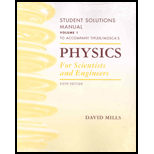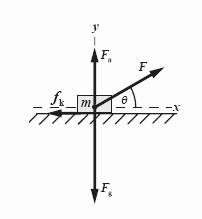
(a)
The work done by the applied force.
(a)
Explanation of Solution
Given:
The mass of sled is
The coefficient of friction between sled and road is
The distance traveled by sled is
The force applied to the sled is
Formula used:
Write the expression for work done by external force.
Here,
Calculation:
Substitute
Conclusion:
Thus, the work done by external force is
(b)
Theenergy dissipated by friction.
(b)
Explanation of Solution
Given:
The mass of sled is
The coefficient of friction between sled and road is
The distance traveled by sled is
The force applied to the sled is
Formula used:
Write the expression for friction force.
Here,
Write the expression for thermal energy.
Here,
Substitute
The free body diagram of sled is given below.

Write the expression for resultant force in vertical direction.
Here,
Substitute
Substitute
Calculation:
Substitute
Conclusion:
Thus, the energy dissipated by frictionis
(c)
The change in kinetic energy of the sled.
(c)
Explanation of Solution
Given:
The mass of sled is
The coefficient of friction between sled and road is
The distance traveled by sled is
The force applied to the sled is
Formula used:
Write the expression for work done by external force.
Here,
Write the expression for friction force.
Here,
Write the expression for thermal energy.
Here,
Substitute
The free body diagram of sled is given below.

Write the expression for resultant force in vertical direction.
Here,
Substitute
Substitute
Total energy of sled is conserved at all points. Work done by external force is equal to the sum of change in gravitational potential energy, kinetic energy and thermal energy.
Write the expression of work done by external force.
Here,
The height of sled is constant all the time; so, change in potential energy is zero.
Substitute
Calculation:
Substitute
Substitute
Substitute
Conclusion:
Thus, the change in kinetic energy of the sled is
(d)
The speed of sled after it has traveled
(d)
Explanation of Solution
Given:
The mass of sled is
The coefficient of friction between sled and road is
The distance traveled by sled is
The force applied to the sled is
Formula used:
Write the expression for work done by external force.
Here,
Write the expression for friction force.
Here,
Write the expression for thermal energy.
Here,
Substitute
The free body diagram of sled is given below.

Write the expression for resultant force in vertical direction.
Here,
Substitute
Substitute
Total energy of sled is conserved at all points. Work done by external force is equal to the sum of change in gravitational potential energy, kinetic energy and thermal energy.
Write the expression of work done by external force.
Here,
The height of car is constant all the time; so, change in potential energy is zero.
Substitute
Write the expression for change in kinetic energy.
Rearrange the above expression in terms of
Here,
Calculation:
Substitute
Substitute
Substitute
Substitute
Conclusion:
Thus, the speed of sled after it has traveled
Want to see more full solutions like this?
Chapter 7 Solutions
Physics For Scientists And Engineers Student Solutions Manual, Vol. 1
- A 500-kg dragster accelerates from rest to a final speed of 110 m/s in 400 m (about a quarter of a mile) and encounters an average frictional force of 1200 N. What is its average power output in watts and horsepower if this takes 7.30s?arrow_forwardRepeat the preceding problem, but this time, suppose that the work done by air resistance cannot be ignored. Let the work done by the air resistance when the skier goes from A to B along the given hilly path be —2000 J. The work done by air resistance is negative since the air resistance acts in the opposite direction to the displacement. Supposing the mass of the skier is 50 kg, what is the speed of the skier at point B ?arrow_forwardWhen jogging at 13 km/h on a level surface, a 70-kg man uses energy at a rate of approximately 850 W. Using the facts that the “human engine” is approximately 25 efficient, determine the rate at which this man uses energy when jogging up a 5.0 slope at this same speed. Assume that the frictional retarding force is the same in both cases.arrow_forward
- The force exerted by a diving board is conservative, provided the internal friction is negligible. Assuming friction is negligible, describe changes in the potential energy of a diving board as a swimmer drives from it, starting just before the swimmer steps on the board until just after his feet leave it.arrow_forwardCite two examples in which a force is exerted on an object without doing any work on the object.arrow_forwardA baseball of mass 0.25 kg is hit at home plate with a speed of 40 m/s. When it lands in a seat in the left-field bleachers a horizontal distance 120 m from home plate, it is moving at 30 m/s. If the ball lands 20 m above the spot where it was hit, how much work is done on it by air resistance?arrow_forward
- A 200-g steel ball is tied to a 2.00m “massless” string and hung from the ceiling to make a pendulum, and then, the ball is brought to a position making a 30 angle with the vertical direction and released from rest. Ignoring the effects of the air resistance, find the speed of the ball when the string (a) is vertically down, (b) makes an angle of 20 with the vertical and (c) makes an angle of 10 with the vertical.arrow_forwardDescribe a situation in 4iich a force is exerted for a long time but does no work. Explain.arrow_forwardCalculate the power output needed for a 950-kg car to climb a 2.00 slope at a constant 30.0 m/s while encountering wind resistance and friction totaling 600 N.arrow_forward
- A particle of mass 2.0 kg moves under the influence of the force F(x)=(5x2=7x)N . Suppose a frictional force also acts on the particle. If the particle’s speed when it starts at x=4.0 m is 0.0 m/s and when it arrives at x=4.0 m is 9.0 m/s, how much work is done on it by the frictional force between x=4.0 m and x=4.0 m?arrow_forwardWhat is the dominant factor that affects the speed of an object that started from rest down a frictionless incline if the only work done on the object is from gravitational forces?arrow_forwardUsing energy considerations and assuming negligible air resistance, show that a rock thrown from a bridge 20.0 m above water with an initial speed of 15.0 m/s strikes the water with a speed of 24.8 m/s independent of the direction tin own. (Hint. show that (Ki+Ui=Kf+Uf)arrow_forward
 University Physics Volume 1PhysicsISBN:9781938168277Author:William Moebs, Samuel J. Ling, Jeff SannyPublisher:OpenStax - Rice University
University Physics Volume 1PhysicsISBN:9781938168277Author:William Moebs, Samuel J. Ling, Jeff SannyPublisher:OpenStax - Rice University Physics for Scientists and Engineers: Foundations...PhysicsISBN:9781133939146Author:Katz, Debora M.Publisher:Cengage Learning
Physics for Scientists and Engineers: Foundations...PhysicsISBN:9781133939146Author:Katz, Debora M.Publisher:Cengage Learning Physics for Scientists and Engineers, Technology ...PhysicsISBN:9781305116399Author:Raymond A. Serway, John W. JewettPublisher:Cengage Learning
Physics for Scientists and Engineers, Technology ...PhysicsISBN:9781305116399Author:Raymond A. Serway, John W. JewettPublisher:Cengage Learning Principles of Physics: A Calculus-Based TextPhysicsISBN:9781133104261Author:Raymond A. Serway, John W. JewettPublisher:Cengage Learning
Principles of Physics: A Calculus-Based TextPhysicsISBN:9781133104261Author:Raymond A. Serway, John W. JewettPublisher:Cengage Learning College PhysicsPhysicsISBN:9781305952300Author:Raymond A. Serway, Chris VuillePublisher:Cengage Learning
College PhysicsPhysicsISBN:9781305952300Author:Raymond A. Serway, Chris VuillePublisher:Cengage Learning Glencoe Physics: Principles and Problems, Student...PhysicsISBN:9780078807213Author:Paul W. ZitzewitzPublisher:Glencoe/McGraw-Hill
Glencoe Physics: Principles and Problems, Student...PhysicsISBN:9780078807213Author:Paul W. ZitzewitzPublisher:Glencoe/McGraw-Hill





